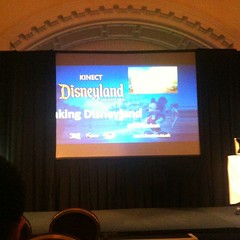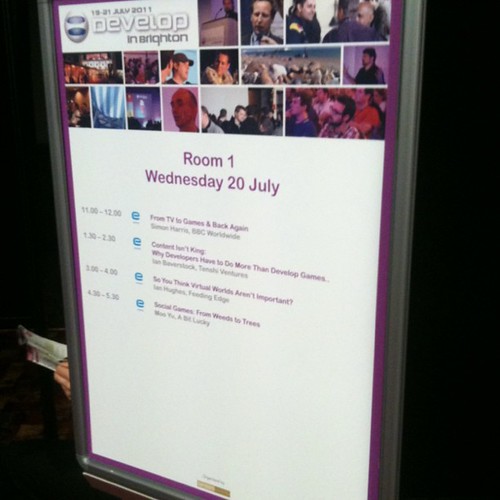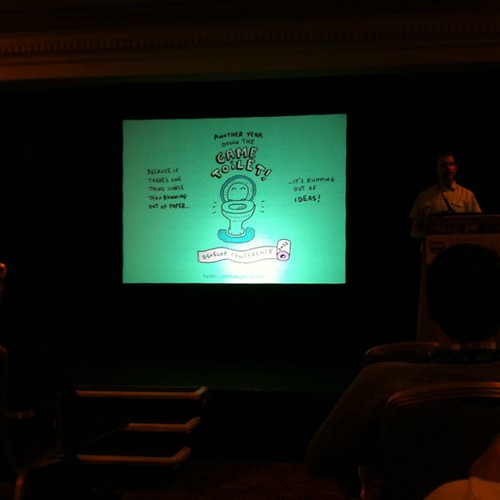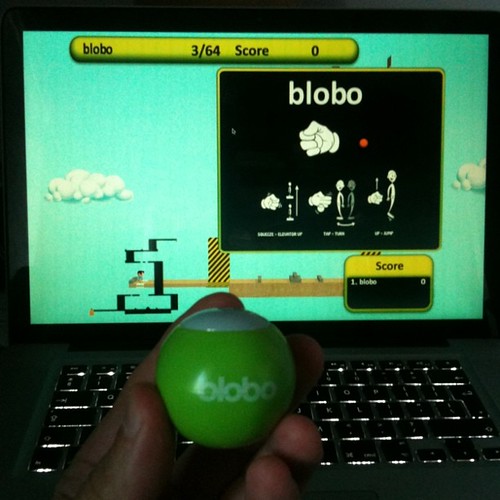Here is another reason I should probably stick to using an avatar! This is AirBand on the Xbox Kinect. Which ever instrument you mime, guitar, drums or keyboard it picks up your position and lets you play the track (its kind of like a paperjamz guitar).
I hope mistsuzuki racing doesn’t mind the product placement of their shirt and logo in this piece 🙂
If you are having trouble with Kinect labs BTW, as it currently bluescreens for a lot of people then you can launch Air Band from the quicklaunch via the silver button menus, the save for Avatar Kinect.
I was trying to get footage of the predlets but they were getting so into it it was impossible to dive in and hit save on the video.
It is a pity you cant really play much in teh way of music it is a sequencer volume control, but can you imaging trying to do this 10 years ago? Brilliant fun and shows that AR doesn’t have to be all marketing and mapping
games
Real and Virtual game merging – 3D print armour?
I was just catching up on the gamescom content on Xbox Live and amongst all the variants of Call of Duty and other shooters there was a trailer for Skylander:Spyro Adventures
I must have missed this too in the E3 2011 press as it is an interesting evolution of the offline/online interactions in games. The game comes with physical toys, 3 or them who are characters from the game. They are amongst a large set of character collectibles. So unlike many games now with DLC that you buy to unlock new features, here you get a toy that act as your unlock. Now we have seen things where the to has a code on it to unlock features, kinectimals being the most recent and some of the pet virtual worlds with cuddly crossovers. This toy is, however, active. You place it on a peripheral base and that detects the toy, but the toy (or some online key combination with the specific instance of the toy) keeps its stats and experience. The aim being you can take you version of the toys to a friends has, and play on.
Again this is not totally new (what is!) as the old dreamcast version of Sonic had a Chao “Tamagotchi” in the VMU (a detachable battery pack/and LCD mini screen on the controller). That was of course a good few years ago, before we had such great connectivity and high end consoles.
The merging of online and offline and considering your brand and the experience as a real interlinked one is certainly a growing business direction in entertainment. Just take a look at how huge Moshi Monster has become (you can find mine at http://www.moshime.com/epredator). Much of this comes from the idea that things are experiences to be shared wherever you are. It is ironic that the video games that were once though to be isolationist, selfish experiences once connected to the internet have become a massive social movement with a knock on into what people might think of as regular product.
You can probably see too that the natural extension of this online/offline activity is for the online activity to create the offline for you with 3d Printing. It would be great with this Spyro example if after playing it was obvious you character had levelled up as you toy now had some new armour on it you got from your friends 3d printer after playing the game?
A very clever realtime 3d scanning using kinect
SIGRAPH 2011 always brings out some very interesting tech. I always think of it as being mainly high end very expensive leading edge graphics. This year though some researcher have provided something very cool and useful that side steps the expensive LIDAR scanning process to capture full 3d environments using just a (now) humble Kinect.
Point cloud data is often used to capture environments that already exist and then it is generally turned into a polygon mesh to be manipulated and re-rendered. Second Life is famously moving from its prim based display to start to allow these polygon meshes as that has been the traditional way yo show games graphics. However this is could all be up in the air a little with the guys at Euclideon who have this newer approach to rendering. Rather than polygons they use an atomic approach. it is really a 3d pixel or voxel.
So look out for Euclideon and their technology, it is an exciting time to see new and interesting ways for us to both create, interact and modify environments.
Both advances have implications for merging real and virtual spaces in either direction as part of augmented reality.
Develop conference Day 2 and 3. A wind of change?
In all the google+ messing around I had not got around to writing up my remaining thoughts and experiences at the Developer 2011 conference in Brighton. Day 1 for me was the Evolve conference a sort of future thinking bolt on that is gaining some traction with the industry. The Evolve strand then blends into the next 2 days which are the official Develop conference when everyone else turns up.

Breakfast Serendipity
The day started heading down in the lift from the 6th floor. I was already wearing my badge and a fellow delegate asked me at the lift where the registration desk was. we got chatting and then sat and had breakfast. The usual sort of conference chat, who are you what do you do. The bizzarre thing was that my fellow delegate was called Iain, (I am Ian of course). It also turned out we were both doing a presentation at 3pm that afternoon. This was Iain McCaig who was going to be doing the Art Keynote as an artist and conceptual designer. For those of you who don’t know he has worked on some the biggest movies and characters including creating Darth Maul! of all time. Clearly I was going to lose a “who does the coolest things” competition but we were actually talking about our shared interest in inspiring kids to create. For him it was drawing for me it was tech. We talked about 3d printing a bit too. As he is from the movie biz it was the first time anyone has said in a matter of fact way “yes we use those all the time”. I left breakfast completely inspired and to be speaking some of the same language and ideas as someone so successful gave me a real buzz.
More Media Molecule
In a reprise of last year the opening keynote was the guys from Media Molecule talking about their journey with Little Big Planet. It was done as an interview style with Phil Harrison. For anyone at previous Develops they will have heard many of these stories before. However it is interesting stuff. There was, of course a little more about Phil and Sony’s side of things. The key people who green lit LBP.
TV to Games and Back Again
The next session I popped into was part of the Evolve track, it was also in the room I would pitch in later so it all fitted nicely. Simon Harris of BBC worldwide explained the different approaches BBC Worldwide (the commercial arm of the BBC) is approaching tight integration of TV and games and the various other offline media. In many ways it was similar to the Moshi Monsters direction from the day before. It is not about bolt ons or after thoughts to cash in but about enriched branded experiences. There was a lot about Torchwood and how the growth of this to a US based series was also joined with specific threads being written for episodic games that track and augment the TV show. Top Gear also was very prominent with the deal to weave Top Gear into the Forza 4 experience. Though they did have to get Clarkson to re-record he dialogue as when it went to the certification boards it was not longer a 3+ game but had moved up to teen ranking. The future of the BBC in games and related interesting content seems assured with a lot of focus and investment and this very rich integration. A great session.
Mickey Mouse gaming
The post lunch keynote was the gaming legend David ‘elite’ Braben talking about of all things a virtual world 🙂 There were some amusing moments with the projector, that decided to clip the presentation (which did get sorted. Not a great picture but ‘king Disneyland’ made me laugh anyway.

This virtual world is Frontier’s new game in conjunction with Microsoft and Disney. It is Disneyland adventures. They have completely and perfectly modelled the California disneyland and players are able to wander around the park using where they then join in in rides, quests, minigames etc. This did look very cool though we did see the same attract loop a good few times. David talked about the language of the Kinect and how we are all forming the vocabulary of interaction. In his game you navigate by pointing, but not with a tiring arm out point, but an elbow at your side at 90 degrees movement, using a turn of the shoulders to go left and right. The attention to graphic detail had to be obsessive as this is disney, and being a real place that millions have visited and will visit it had to be a mirror world location.

So you think virtual worlds aren’t important
This was me and my first foray into persuading people in the game industry of the changes brought about by virtual worlds and 3d printing. I gave a live demo of Opensim too. Of course The Cool Stuff Collective features as well as this is validation that if you don’t get this tech and its uses then next generation already are because we are telling them about it. I also dropped in unifier and kitely as examples of services that are evolving to support the demands for virtual worlds. This was very handy as I had an audience question that it was too much messing about to get into a virtual world to have a meeting. My answer was that people are trying to simplify it, but it is also based on demand. if the games industry applied its approaches to running and hosting, and to usability they would have a whole new market to reuse and expand into. They wont do that until they are made aware there is a need.
I also did a straw poll in the room of how many people had heard of the BCS. There was only 1 hand went up which is indicative of the work we have to do to help people in their careers in the games industry.
Raspberry Pi
It was back to David Braben again, this time at the other strand of the conference Games:edu. I already explained a little about this over here. Create a computing device so simple and cheap that allows kids to explore and program. As opposed to just being able to play and consume. This fills the chasm between the creativity of little big planet and other creative tools to the world of computer science. I am very hopeful as whilst we harped back to the 80’s back then we only had the computer to write code on. we did not have the feeder of the creative platforms, the virtual worlds and UGC were not a thing we experienced.
Day 3 – More 3d
Day 3 began rather like day 2 with a reboot of a previous years presentation. This was Mick Hocking of Sony talking about a year of PS3 3D. Last year it was a lot of slides and a quick demo we all had to crowd around. This year we were all in the Odeon with passive 3d specs on. It was a good pitch when we saw examples of design considerations actually played out in 3d. breaking planes, reversing images, forcing convergence and divergence past comfort levels. However a lot of it was 3d powerpoint which was really very annoying. It was a waste of the tech and the time to float bullet points IMHO.
I missed the next session as I was having a few meetings and conversations about beta’s and new tech with people.
Finally the next 2 sessions were the best of the entire conference.
Happily ever after: The Story of one girl’s refusal to delegate
Nat Marco from Honeyslug told a brilliant story of how she was persuaded into learning to code a game in LUA and XML by Ricky. I knew this would be good as I was enthralled at the Kahoots story last year from Honeyslug
How this led to a whole host of remote working relationships with artists around the world producing content for her. She also talked about the relationship with a script writer and how Nat made sure she imposed her own direction and creative will to keep her project how she wanted it to be. It was lighthearted, yet covered some very important points. The team that worked around Nat was global, it was not about co-location. The programming she had to learn was a start, and she saaid it was not as bad as she thought. She was also completely immersed (and supported in that immersion by a publisher) in the project in order to maintain its quality at every stage.
Another year down the gaming toilet
I met Ricky back at the first independent keynote I did at the ACE conference in 2009 and I know we share a lot of the same ideas and humour. Last year he told me I must go to this one particular session. I didn’t get to it but this year I made sure I did as it was running again.

Jerry Carpenter is an artists and developer, he has spent years, each day on a bus on the way to work, writing down short crazy, eccentric and bizarre games ideas. He has a completely different presentation style to anyone else as it kind of rambles, bumbles then hits you square in the eyes with a flash of genius or comedy or both. His inspiration for describing mad/bad games was someone commented one of his games was like watching paint dry. So he made a watching paint dry game that you could only win by sitting watching the paint dry for 24 hours 🙂 So his entire site is now dedicated and full of these brilliant cartoons and succinct ideas for a game. Much of it is NSFW BTW :). I loved 1080 qwerty extreme – a game where you turn you keyboard upside down and stand on it to snowboard, and Ultimate feline optimal area tester (a cat swinging game in a room). The ideas do stand up on their own buy the way he tells about the train of thought had us all in stitches and was brilliant. He should have his own show 🙂 Much of what he shows hits at the heart of some of the terrible grind that is part of social gaming at the moment and is combined with film and political references too. if you get a chance to see him speak please go!
I decided I needed to get back home after that. I could not see anything topping those two sessions for inspiration so I headed on back, collecting all my 3ds spot pass new connections one the way. I look forward to another great conference next year.
Develop 2011 Day 1: less starstruck more enthused
This year was my annual pilgrimage to Brighton for the games dev conference called Develop. I have going to this since I chose my independent career path with Feeding Edge. What I do and what I work on is still at the periphery of the games industry compared to the full on AAA title producer firms, but I do have a huge affinity for the indies.
After last year, sitting hearing something was impossible in one of the sessions, when in fact it is exactly what Second Life and Opensim do I was determined I needed to push a few more game company buttons and so volunteered to talk this year and was accepted. I was part of the Evolve stream which is all about new stuff. In a fast moving innovative industry like the games industry it is surprising that many of the things I have to share are still so leading edge, or if not leading edge then woefully ignored.
The industry itself has a huge part to play in where virtual world and online communication fit into the our lives. They have all the tech and know how to get a double bonus from assets. Games are inherently fun and cool, with very a very creative core at the start, then though they become product. Each game follows the same path as any startup, passionate founders, workers making it real and then the dreaded monetization.
It is also still amazing that all these multi site studios with outsourcing etc are not clamouring to use more efficient or creative ways to communicate with one another, that includes the very things they are building.

I think there was a set unifying sentiments, backed up by some action this year though. Three years ago hardly anyone bothered with “social”, last year everyone botched about it, this year everyone wants to do it properly and better. There is also that realisation that developer community is shrinking, the grand masters are getting older, kids are not getting into programming. It’s not really even being taught. From the newest quirkiest indie dev’s, to higher education to the grand masters of UK game development and even to me with my Cool Stuff Collective show strand we are all doing things to try and let people know that there is more to tech than just using it. You can build with it, you can program, you can share and rather oddly there has never been a better time to be able to get together with others and build. There is though a gap in the technology, which was brought out in David Braben’s Raspberry Pi session. The driver behind this is to try and push towards a small very simple device that you can just plug into a screen and get to code, create build share. In a way that it is not complicated to hit the reset button, just as we did in the old 8 bit days. Lots of kids have access to computers but not to develop on, as they may “break them”.
It really is a great plan and aiming to make a £15 machine with a developer community building the right tools for it and then giving those to entire classes years at schools really opens up the potential for a massive wave of technologically capable builders. In the session the spectre of school ICT came up. How once ICT was brought in computer science dropped out. ICT is about using basic tools on a computer, all skills that are needed, but programming is about problem solving and making things happen. My 8 year old (predlet 1.0) referred to here ICT as “I correct text” which I guess she heard somewhere. It is very different learning to drive a car to knowing how to build one. You need both avenues to be available.
Anyway my highlights of Develop
1. New Stories for New Platforms : A great freeform conversation between Adrian Hon, Alexis Kennedy, David Varela and Charles Cecil moderated by Patrick O’Luanaigh. This was away from the pure tech of games and into the narrative. Dicussions of the stories that form in playing simple board games, storyline narrative versus multiplayer shared experiences. Charles Cecil told some tales of how they remastered broken sword on the mobile years after they had thrown all the assets away.
2. Browser – The place where console, web and social games come together Ilkka Paananen. This was partly an advert for gunshine.net but it was based on experience of pushing to the browser. The mechanics of doing social features better seemed to be a theme too. In Gunshine your friends characters become available to play as your team mates but they play in the style of your friend as AI’s. They also get to level up for the other player (or atleast you can reward them for having been picked). So if you play well, you are more likely to get picked for the team.
3. Gamification – Extending the Game Play into business. Mo Touman gave a pitch on gamification. Which in itself had become a word that was both loved and hated in equal measure. Mo gave examples of lots of platforms toolkits that help with some of the basics of light gamification. Badges, points etc. He challenged the games industry to look at middleware. The tendency was to build from scratch still, which is fine if money is no object. He pointed out things like openfeint, plus+, bunchball(nitro participation engine), scoreloop. Bunchball is the one I need to take a look at having explored the others. In the QA the objections to gamification tended to be they indicated lazy bolting on of points. In fact this is a much deeper subject but I guess the early examples are just that.
4.Social Games, Music and Fashion : New frontiers. Paulina Bozek from INENSU gave a great pitch on their social clothed reuse/swapping project and also the up and coming superfan for the music industry. What I liked was the references to the madness of the record industry in trying to control and stifle creativity in the name of profit. Which in the long run fails. The example was of a Bieber fan video, lots of fans had put a montage of photos of themselves each with a word from the song written on a hand, a mirror, a placard etc and posted it to youtube. Bieber commented on how cool it was and that he liked it, then his record company proceeded to issue DMCA takedowns all over the place for breach of copyright. Hitting at the hardcore fans who want to share and create out of passion and interest is, lets face it, dumb.
5. What’s Next. A great panel which included Alice “@wonderlandblog @makielab” Taylor. It was lots of riffing on some ideas, Onlive and Xbox were both represented too. One discussion was have the consoles got good enough that we don’t need to bother pushing forward with the visuals any more. Will there be a next next gen etc. generally we all wanted to not have to bother with worrying what something was on, but be able to play anything anyway.
6. Keynote: Lessons from building Moshi Monsters to 50m Users. Michael Acton Smith was his usually chirpy and enthusing self. Telling tales of the dark days of nearly closing, of burning capital, changing course and then the explosion that is Moshi and moving into other non digital areas. To see the empire grow from those early ideas (which I remember seeing on a visit to mind candy way back) to what it already is and to see where it is heading really is like watching a new Walt Disney arise from the web. (Well done to Moshi Monsters for picking up their award at the ceremony the next day too)
More to come….
Get the next generation educated – making games
Today a report was published by NESTA written by Ian Livingstone OBE and Alex Hope into the educational and institutional shortcoming and development needs to ensure that ‘the UK can be transformed into the world’s leading talent hub for video games and visual effects.’ I realise the Uk angle is rather parochial but it is important to all countries and organisational units to pay attention to this.

(picture from NESTA with Little Big Planet Copyright Sony Computer Entertainment
The full report is here.
The report attracted my attention with my BCS animation and games development group hat on. The BCS as an IT professions organization seeks to offer an umbrella for the growth of skills and the nurturing of talent and interest in the technology sector. (Formerly called the British Computer Society). The BCSAGD group is trying to help promote awareness of the depth of skills and talent in the games industry as much as it is trying to help the games industry map to what goes on in the apprently more serious IT industries.
Having worked across all these industries, and now also encorouaging kids into tecnology via The Cool Stuff Collective TV show I know that whilst games have some specific challenges the core of the industry has the same profile as an computing based industry. The challenges of design, code, test and run and having to deal with constant disruptive innovation applies to all industries. It benefits, though, from being things that people can see and create. You don’t teach music by showing the inside of a piano, but its great to know how it works to get the best out of it.
I think the reach of the BCS into traditional games industries is pretty low, yet when you read this reports findings you cant help but notice we are all heading for the same noble goals.
The following is an extract of the key reccomendations from the above report.
Schools
Bring computer science into the National Curriculum as an essential discipline.
Sign up the best teachers to teach computer science through Initial Teacher Training bursaries and ‘Golden Hellos’.
Use video games and visual effects at school to draw greater numbers of young people into STEM and computer science.
Set up a one-stop online repository and community site for teachers for video games and visual effects educational resources.
Include art and computer science in the English Baccalaureate. Encourage art-tech crossover and work-based learning through school clubs.
Build a network of STEMNET and Teach First video games and visual effects Ambassadors.
Introduce a new National Video Games Development and Animation Schools Competition.
Design and implement a Next Generation of Video Games and Visual Effects Talent Careers Strategy.
Provide online careers-related resources for teachers, careers advisers and young people.
Universities, Colleges and Vocational education
Develop kitemarking schemes, building on Skillset accreditation, which allow the best specialist HE courses to differentiate themselves from less industry-relevant courses.
HEFCE should include industry-accredited specialist courses in their list of ‘Strategically Important and Vulnerable’ subjects that merit targeted funding. Industry commits to these courses through industrial scholarships and support for CPD for lecturers.
Raise awareness of the video games and visual effects industries in the eyes of STEM and arts graduates.
Give prospective university applicants access to meaningful information about employment prospects for different courses.
Develop a template for introducing workplace simulation into industry-accredited video games and visual effects courses, based on Abertay University’s Dare to be Digital competition.
Leading universities and FE colleges sponsor a high-tech creative industries University Technical College (UTC), with clear progression routes into HE.
Kitemark FE courses that offer students the best foundation in skills and knowledge to progress into Higher Education.
Training and continuous professional development
Skillset Creative Media Academies and e-skills UK’s National Skills Academy for IT to work with industry to develop specialist CPD training for video games and visual effects industries.
Support better research-oriented university-industry collaborations in video games and visual effects.
Continue to treat the 18 visual effects occupations on the Government’s shortages list as shortage occupations.
So take a look at the report and see if there is anything, either as a BCS member, as a teacher, as a volunteer, as a parent or as a leading employer that you can do to push these goals.
Having seen the enthusiasm of my kids (the predlets) for creating with technology at a young age we really should level up the sort of education opportunities we give young people from the earliest of ages. Scary for the teachers I am sure but there are lots of us out here to help.
More fancy graphics, great integration and a lot of fun
I have been getting increasingly more impressed with Dirt 3 on the Xbox. I did mention it in a post the other week however it has got better still.
On the the really great features of it was the 2 player split screen gymkhana. (Well the whole gymkhana thing all together). Whilst the rallying and racing sections are brilliantly done, great edge of the seat, edge of traction experiences the new X Games Ken Block inspired sections that revolve around stunts and style are a brilliant addition to the genre.
You get to donut, jump, drift, spin and smash your way around a freestyle track in a way that we only usually get to do on Skate games. It is a brilliant freeform mad stuntfest.It also has a new driver assist called tricksteer. This applies in these events and makes it a little more easy to pull off those donuts, still needing some balance and poise but it feels very flattering.
So you get to do things like this and then share them on youtube direct from the game
It also does not take itself too seriously and @asanyfuleno and I spent quite a while the other day playing 2 player split screen “hooning”. It lets you freeform stunt drive around the Battersea power station. It was pure sandbox, no points, just discovering jumps and stunts. We ended up focussing on a jam session on this brilliant little ramp.
So whats all this got to do with anything? Well each of these little clips is from a live performance in the game. The film editing in world is not great, well non existent. It gives you replay which chops from camera to camera as it sees fit. Which sometimes works. The old Skate 2 game introduced some proper camera placement and editing tools to make great skate videos, it would be nice to see that in Dirt 3 too.
As it is you do get some really nice pieces like this Hummer in Kenya in the sunset.
The ease of creation, and sharing as a side effect of playing a very good driving game makes me wonder if we could do a full CGI version of Top Gear. It would be as Clarkson says “The best driving show in thurrr wuuurlld”.
I hope Forza 4 has such good sharing facilities. Then of course we can share our driving videos on out google+ driving circles and not hassle everyone with the gaming equivalent of holiday videos.
Very cool controller – Blobo
At Metameets Toni Alatalo of Playsign (and RealXtend) showed me this gadget he had. I was instantly intrigued and thought it was brilliant. Its a bluetooth based controller that knows its own rotation, directional travel and also if its being squeezed. It Is called a Blobo.

It also has some interesting features where by your avatar and some other information is stored in the ball so you can move it to other blobo owners games and play with them.
I shall certainly be carrying mine around to a few venues and presentations to show people that the world is not all joypad 🙂
Capturing my father’s day moment
This is a really quick one but very related to the initial Metameets post about machinima I just did before my mega post I need to do later.
On getting back home the Predlets had bought me Dirt3 for Fathers Day. I could not resist this integration. The walled garden (but very effective) Xbox 360 links directly to your youtube account and you can publish parts of your replay. There are a few controls on speed and clipping etc. It works though.
I think the stunt section will be interesting, the racing is good but very similar for everyone. (not got to that this was only my 3rd go).
However, it lets me capture my experience in my context and share it.
This sort of thing has been done before to some degree, blur tweeted for instance.
So life performance and expression through car avatars. Even Disney don’t do that with Lightning McQueen and co 🙂
Is that a dancing shoe or a shoe dancing?
E3 this year had some announcements about the Xbox and its Kinect. I was surprised that the Kinect Fun Labs arrived straight away on an update. These are a set of kinect toys and apps, many inspired by the open source pioneers who built applications with as part of kinect hacking.
The one I tried was Googly Eyes. You hold up any object and the kinect scans in the front, and then the back. It then processes for a few seconds and adds comedy googly eyes to give the object some character.
The thing on screen is then controlled by your body movements. So it is just a few seconds from static real life object to a virtual puppet. As you can see here is is one of elemming’s shoes dancing.
It is very well done, I a sure with the right lighting and object you can make things that are much more complicated.
There are another few apps and more on the way to show off advances in what kinect can do. There is also an avatar creator that makes an xbox style AV but that resembles you (something the nintendo 3DS does well too 🙂 )
Very cool, very interesting and I will be exploring it some more.
